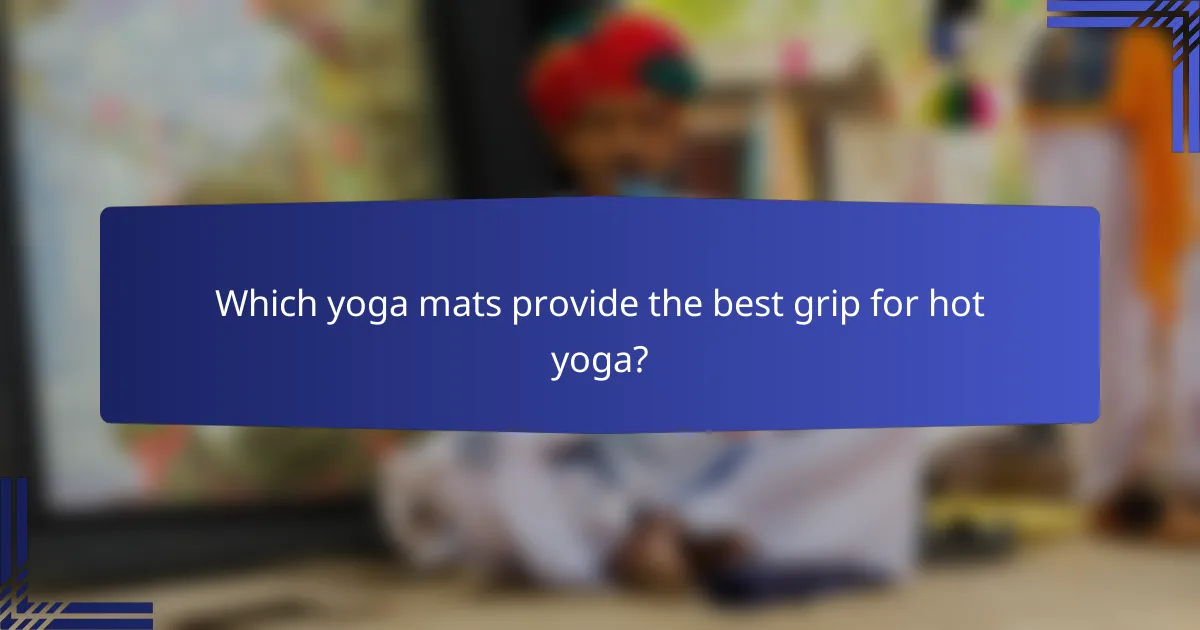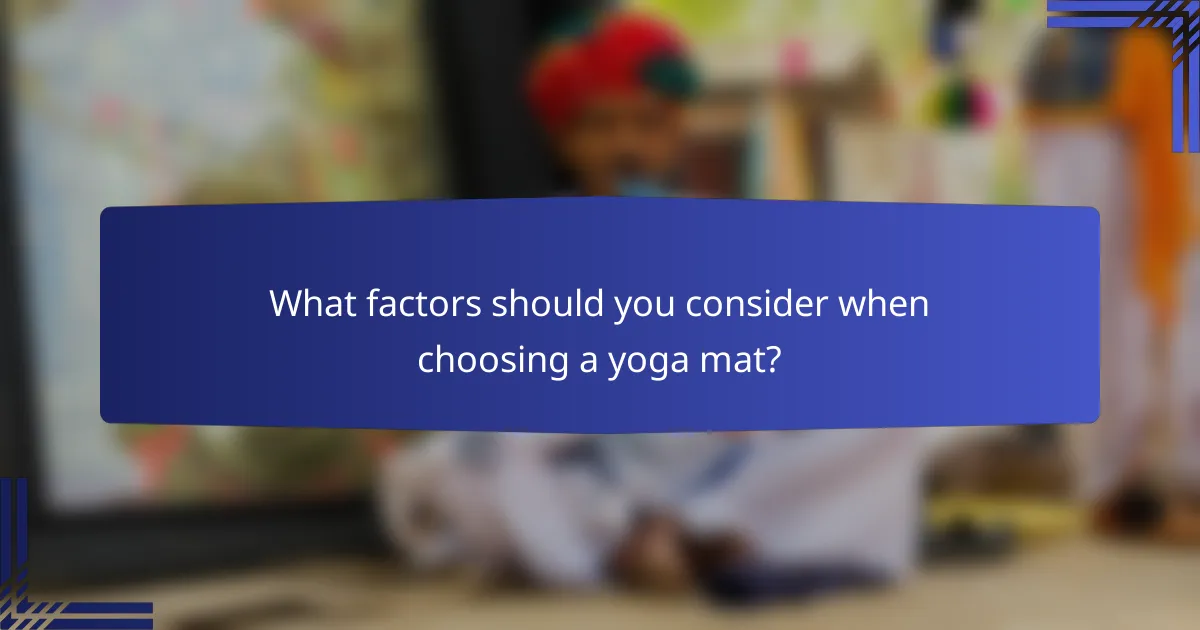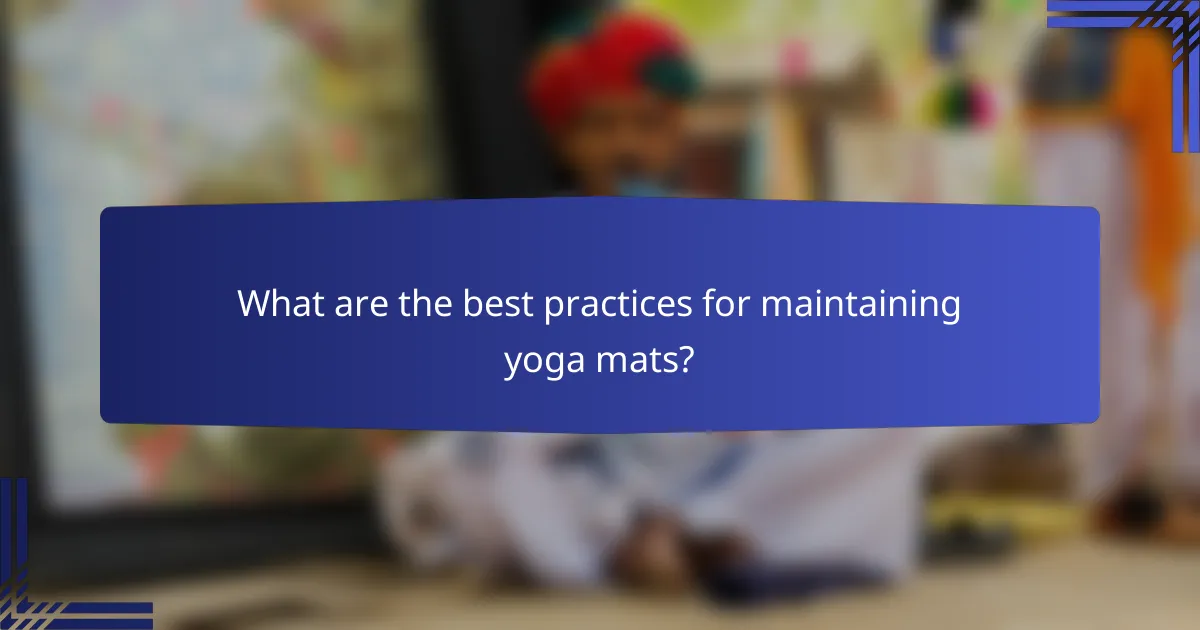Choosing the right yoga mat is essential for enhancing your practice, as it impacts comfort, grip, and durability. Look for mats that provide ample cushioning and a non-slip surface, especially if you practice hot yoga, where superior grip is crucial. Additionally, consider the materials used, as they significantly affect the mat’s longevity and overall performance.

What are the best yoga mats for comfort in the USA?
The best yoga mats for comfort in the USA typically feature ample cushioning, a non-slip surface, and durable materials. When choosing a mat, consider thickness, texture, and overall quality to enhance your practice.
Liforme Yoga Mat
The Liforme Yoga Mat is renowned for its exceptional comfort and grip, making it a favorite among yoga enthusiasts. It features a thickness of about 4.2 mm, providing excellent cushioning while maintaining stability.
This mat is made from eco-friendly natural rubber, which offers a non-toxic surface that is both durable and supportive. The alignment guide printed on the mat helps practitioners maintain proper posture during their sessions.
Manduka PRO Yoga Mat
The Manduka PRO Yoga Mat is a top choice for those seeking durability and comfort. With a thickness of 6 mm, it provides substantial cushioning for joints, making it ideal for various yoga styles.
Constructed from closed-cell PVC material, this mat is designed to resist moisture and bacteria, ensuring longevity. Its dense surface offers excellent grip, even during intense practices, while the lifetime guarantee reflects its quality.
Jade Yoga Harmony Mat
The Jade Yoga Harmony Mat combines comfort with an eco-conscious approach. It is made from natural rubber and has a thickness of around 5 mm, providing a good balance of cushioning and support.
This mat is known for its superior grip, which is enhanced by its textured surface. Additionally, for every mat sold, Jade Yoga plants a tree, making it a socially responsible choice for environmentally minded practitioners.

Which yoga mats provide the best grip for hot yoga?
For hot yoga, mats that offer superior grip are essential to prevent slipping during intense sessions. Look for materials like natural rubber or those with a textured surface designed to enhance traction, especially when wet.
Gaiam Cork Yoga Mat
The Gaiam Cork Yoga Mat combines natural cork with a TPE backing, providing excellent grip even in humid conditions. The cork surface absorbs moisture, ensuring a non-slip experience during hot yoga practices.
This mat is eco-friendly and free from harmful chemicals, making it a safe choice for your workouts. Its thickness offers comfort while maintaining stability, which is crucial for balance poses.
Yogitoes Skidless Mat Towel
The Yogitoes Skidless Mat Towel is designed specifically for hot yoga, featuring silicone nubs on the underside to prevent slipping. This towel can be placed over any yoga mat, enhancing grip and absorbing sweat effectively.
It’s made from recycled materials, making it an environmentally friendly option. To maintain grip, simply dampen the towel with water before starting your practice, which increases traction as you sweat.
PrAna E.C.O Yoga Mat
The PrAna E.C.O Yoga Mat is made from thermoplastic elastomer, offering a good grip without the use of PVC. Its textured surface helps maintain stability during challenging poses, making it suitable for hot yoga sessions.
This mat is lightweight and portable, ideal for yogis who travel. Its durability ensures it can withstand frequent use while providing consistent performance in terms of grip and comfort.

How durable are different yoga mat materials?
The durability of yoga mats varies significantly based on the materials used. Understanding these differences can help you choose a mat that meets your needs for longevity and performance.
PVC Yoga Mats
PVC (polyvinyl chloride) yoga mats are known for their durability and resilience. They can last several years with proper care, making them a popular choice for regular practitioners. However, they may not be the most environmentally friendly option, as PVC is a synthetic material.
When selecting a PVC mat, look for those that are free from harmful chemicals and phthalates, which can be found in lower-quality mats. Regular cleaning and avoiding prolonged exposure to sunlight can extend the life of your PVC mat.
TPE Yoga Mats
TPE (thermoplastic elastomer) yoga mats are a newer alternative that combines durability with eco-friendliness. These mats typically last a few years and are made from non-toxic materials, making them a safer choice for both users and the environment.
TPE mats offer good grip and cushioning, but they may not be as resistant to wear and tear as PVC. To maintain their condition, store them in a cool, dry place and clean them with mild soap and water after use.
Natural Rubber Yoga Mats
Natural rubber yoga mats are highly durable and provide excellent grip, making them ideal for hot yoga and other intense practices. These mats can last several years, but their longevity depends on usage and care.
While natural rubber is biodegradable and environmentally friendly, it can be heavier and more expensive than synthetic options. To maximize durability, avoid exposing your mat to direct sunlight for extended periods and clean it with gentle, natural cleaners to prevent degradation.

What factors should you consider when choosing a yoga mat?
When selecting a yoga mat, consider thickness, material, and price to ensure comfort, grip, and durability. Each factor plays a crucial role in enhancing your practice and meeting your personal needs.
Thickness and Cushioning
The thickness of a yoga mat typically ranges from 1/16 to 1/2 inch, affecting both comfort and stability. Thicker mats provide more cushioning, which can be beneficial for sensitive joints, while thinner mats offer better balance and connection to the ground.
For most practitioners, a mat thickness of 1/4 inch strikes a good balance between comfort and stability. If you practice on hard surfaces or have joint issues, consider a thicker option, while those focused on balance poses may prefer a thinner mat.
Material and Eco-Friendliness
Yoga mats are commonly made from materials like PVC, TPE, and natural rubber, each with different levels of grip and durability. PVC mats are often less expensive but may not be eco-friendly, while natural rubber mats provide excellent grip and are biodegradable.
When choosing a mat, look for certifications such as Oeko-Tex or GreenGuard to ensure the material is free from harmful chemicals. If sustainability is a priority, consider mats made from eco-friendly materials like jute or organic cotton.
Price and Warranty
Yoga mats can range from low-cost options under $20 to premium models exceeding $100. While budget mats may be suitable for beginners, investing in a higher-quality mat can enhance your practice and last longer.
Check for warranties or satisfaction guarantees, as reputable brands often offer these to ensure customer satisfaction. A warranty can provide peace of mind, especially for higher-priced mats that promise durability and performance.

How do yoga mat brands compare in terms of pricing?
Yoga mat pricing varies significantly based on brand, materials, and features. Generally, you can find mats ranging from budget-friendly options around $20 to premium models that can exceed $150.
Manduka vs. Liforme
Manduka mats typically range from $60 to $150, known for their durability and eco-friendly materials. Liforme mats, on the other hand, are priced between $100 and $150, offering excellent grip and alignment guides.
When comparing these two brands, consider the type of yoga you practice. Manduka is favored for its longevity, while Liforme is often chosen for its superior traction and comfort during intense sessions.
Jade Yoga vs. Gaiam
Jade Yoga mats are priced between $70 and $100, made from natural rubber and designed for optimal grip. Gaiam mats are more budget-friendly, typically costing between $20 and $60, appealing to beginners or casual practitioners.
For those prioritizing sustainability, Jade Yoga is a strong choice due to its eco-conscious production. Gaiam offers a variety of designs, making it suitable for users who want a stylish option without breaking the bank.
PrAna vs. Yogitoes
PrAna mats generally fall in the $50 to $90 range, known for their versatility and comfort. Yogitoes, primarily recognized for their towels, offer mats priced around $60 to $100, focusing on grip and moisture-wicking properties.
PrAna is ideal for yogis looking for a balance of performance and price, while Yogitoes mats are great for hot yoga practitioners who need extra grip. Evaluate your practice style to choose the best fit for your needs.

What are the best practices for maintaining yoga mats?
To maintain yoga mats effectively, focus on regular cleaning, proper storage, and techniques to extend their lifespan. These practices help ensure your mat remains hygienic, functional, and comfortable for your yoga sessions.
Cleaning Techniques
Regular cleaning is essential for keeping your yoga mat free from dirt and bacteria. Use a mixture of mild soap and water or a specialized mat cleaner, applying it with a soft cloth or spray bottle. Avoid harsh chemicals that can degrade the material.
For deeper cleans, consider soaking the mat in a bathtub with warm water and a gentle detergent for about 15-30 minutes. Rinse thoroughly and hang to dry away from direct sunlight to prevent fading and cracking.
Storage Recommendations
Store your yoga mat in a cool, dry place to prevent moisture buildup, which can lead to mold and mildew. Rolling the mat is preferable to folding, as folding can create creases that affect its performance.
Using a dedicated mat bag can protect it from dust and damage when not in use. If you frequently travel with your mat, look for lightweight, portable options that offer additional protection.
Longevity Tips
To extend the life of your yoga mat, avoid practicing on rough surfaces that can cause wear and tear. Additionally, try to keep your mat away from extreme temperatures, which can warp or degrade the material.
Rotate your mat regularly to ensure even wear and consider using a towel on top during particularly sweaty sessions to reduce the need for frequent cleaning. Following these tips can significantly enhance the durability of your mat.
